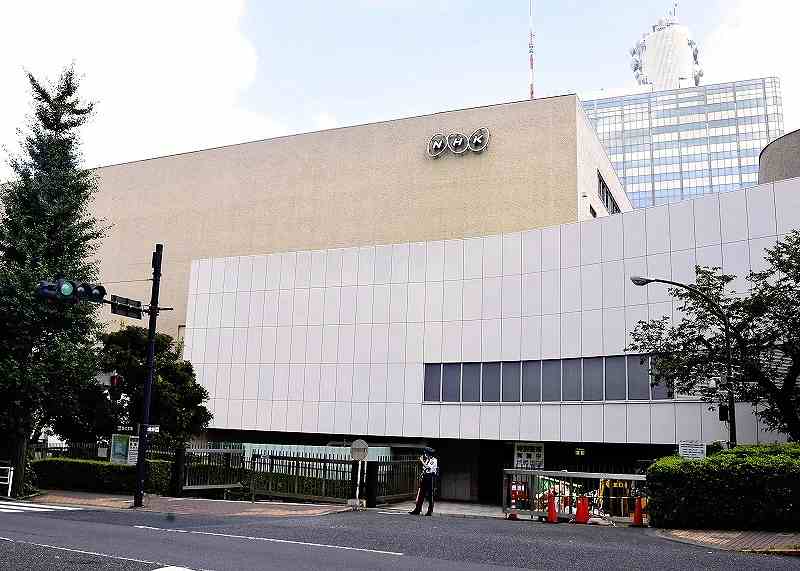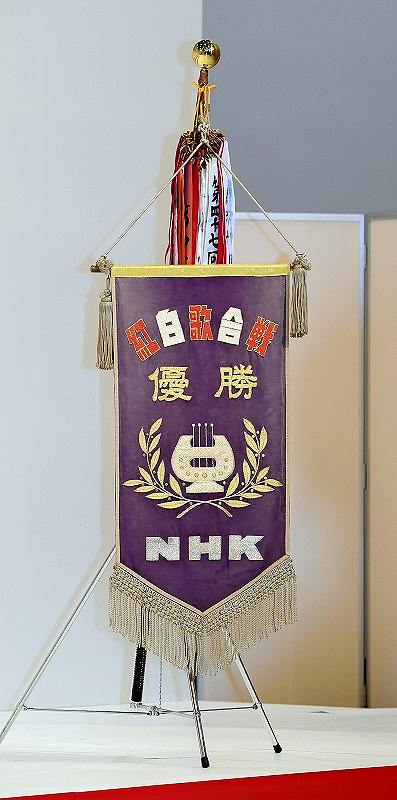
The NHK Broadcasting Center in Shibuya, Tokyo
4:00 JST, March 27, 2021
NHK has declared that it will begin streamlining its organization over the next three years as it faces more pressure than ever to reform its business model, such as reducing the receiving fees collected from the public.
If you have a TV, you are required to pay such fees, so it is natural to be curious about NHK production costs. How much money is allocated for each program, such as for NHK’s annual historical dramas and “Kohaku Utagassen” (Red & White Year-end Song Festival)? I recently looked into such questions.
‘Leaner and stronger’
As NHK’s surplus funds have surpassed ¥120 billion, its management plan for fiscal 2021-23, released in January, attracted the attention of the public because of the likelihood the receiving fees would be lowered.
A majority of NHK’s business operating expenses, which are funded by the collected receiving fees, go to programming production costs. Therefore, if you discuss NHK’s reform, you must scrutinize each of its program’s production costs.
Regarding this point, the management plan emphasizes a review of program costs and other expenses for the making of a “leaner and stronger” NHK. The plan also states that the total amount of production will be reduced while improving the quality of each program and that the existing system of managing content by channel will be changed to managing by genre, thereby avoiding programs with similar content and assessing costs more strictly.
So, just how much does NHK allocate to each program?
The broadcaster explains this matter in briefing material released every January for the upcoming fiscal year’s budget. The production costs listed mainly consisted of direct costs such as appearance fees, personnel costs and equipment expenses.
The data shows that programming that falls under genres such as hobbies, intellectual interests and health can be produced at a lower cost, with some being possible at about ¥600,000 per broadcast.
In contrast, entertainment programs require much more. Dramas had ¥79 million allocated per broadcast while ¥35.4 million per broadcast went to programming in the entertainment and music genre.
Looking at the titles of some programs, I’m guessing that appearance fees for entertainers must have been very high. However, NHK provided no further information.
I asked NHK’s Public Relations Department about specific production costs for annual historical dramas, the educational show “Chiko-chan ni shikarareru!” (Chico Will Scold You!) and the documentary program “NHK Special.”
“In principle, we do not disclose the costs of each broadcast, as they are deeply related to editorial control,” was the response. “To deepen public understanding of how we use the receiving fees, we release approximate production costs per broadcast for programs of each genre.”
However, I did find disclosed production costs for programs from fiscal 2006-08. In fiscal 2008, ¥59.1 million was allocated for each episode of the annual historical drama “Atsuhime” (Princess Atsu).

The winner’s flag for the annual “Kohaku Utagassen” song contest
As for music programs, ¥32.9 million was allocated for “BS Nippon no Uta” (Songs of Japan on a satellite broadcasting channel) and ¥24.6 million for “NHK Kayo Concert” (NHK songs concert), while ¥16.8 million went to “Tameshite Gatten,” a lifestyle information program and the predecessor of the current “Gatten!”
In the following fiscal year, NHK introduced its current system of not publicizing program production costs, stating that they are heavily tied to editorial control.
In fact, production costs for “Kohaku Utagassen” have never been disclosed, even under the previous system. During a December briefing, the chief producer only said that he would “refrain from answering [questions] about the program’s budget.”
Reducing satellite channels
Programming evaluations vary depending on the subjective nature of each person’s opinion. Program producers and directors are given discretion over various details of the program, such as who will appear and how it will be made, which corresponds to editorial control.
NHK in recent years has been criticized for being similar to commercial broadcasters in the content and direction of its programs and has also been accused of excessive publicity. The broadcaster also faces criticism for airing too many drama programs and casting too many girl group and boy band members to appear in them.
Of course, it should be noted that the public broadcaster offers many excellent programs, including such documentaries as “NHK Special” and “ETV Special” and drama series that have won awards at the Cultural Affairs Agency’s National Arts Festival, which gives NHK a prestige that commercial broadcasters do not have.
NHK’s recently released management plan also included a decision to reduce the number of satellite (BS) channels from the current four to three by the end of fiscal 2023. As fewer channels will mean an inevitable drop in the number of programs, this decision falls in line with NHK’s goal of streamlining.
This change, however, is scheduled for some time from now and program production changes in fiscal 2021, which will begin next month, remain insufficiently clear. At a February press conference, distributed materials only mentioned a few new programs and nonspecific ideas, such as creating a program development zone that pursues the new NHK style with about 50 broadcasts at night on its NHK General TV, and producing high-quality content at reasonable costs with a policy to manage programs by genre.
Supreme Court ruling
As viewers are forced into a contract with the NHK requiring the payment of receiving fees, many are curious as to what programs are being produced and at what cost. Article 64 of the Broadcast Law stipulates that a person installing receiving equipment capable of receiving NHK broadcasts has to enter a contract with NHK.
As long as you own a TV set that can show NHK programs, you cannot avoid the contract, no matter how little you care for the programming.
The receiving fees have been regarded as a special burden to maintain and operate public broadcasting.
A 2017 Supreme Court ruling describes the receiving fees as a “burden assumed widely and fairly by those who are able to view NHK broadcasts so that the NHK is financially neither controlled nor affected by specific individuals or groups, nor central governmental organizations.” Behind the collection of receiving fees is the premise that NHK is a public broadcaster.
The current public broadcaster NHK was established in 1950 under the Broadcast Law, which also stipulates the receiving fee system. The system was initially applied to radio broadcasting and then to TV broadcasting, which started in 1953. The radio fee system was abolished in 1968.
This indicates that the concept of a public broadcaster funded by receiving fees emerged due to the social conditions in the early post-World War II period.
Media today has drastically changed from that time, especially when it comes to the dominant role NHK played in providing entertainment and educational information to the public during the dawn of TV, when commercial broadcasters were just getting off the ground.
In this sense, it is time for NHK to reevaluate the meaning of the “public” in public broadcasting. This task corresponds to “NHK is pursuing a new identity,” emphasized in the new management plan, even though what it is and how to achieve that remains unclear.
I asked the broadcaster for something more concrete, but the response I got was only that NHK “will take a fresh look at and examine each of the things that only NHK can do as a public media corporation funded by receiving fees in a time when the media environment and viewer behavior are drastically changing.”
Contribution to the public
Discussions on the public nature of broadcasting, including commercial broadcasting, are becoming more pronounced.
“How do you define ‘public’ in creating a broadcast?” said Keio University Prof. Hiroaki Miyata, who specializes in data science, at an online symposium organized by the NHK Broadcasting Culture Research Institute on March 5. “Many producers only look at things like ratings. Can you really say that they have contributed to the public by doing so?”
He also suggested that broadcasters should not only have the traditional perspective of providing broadcasts for many people, but also “ask specific questions taking individuals into consideration.”
I guess that he meant they should make programs that take a more in-depth approach to solving specific social problems, and that is where we can find publicity.
“Broadcast programs do not always have to present a clear, single answer to every problem,” said Riken Komatsu, a community activist in Iwaki, Fukushima Prefecture.
“We need an attitude of making programs that ask questions and leave room for us to think about them.” He added: “Such questions generate social movements, which lead to new ways of communication. The media should move in tandem with communications.”
NHK should rethink its original point — asking itself about its public nature on a different level from commercial broadcasters that show advertisements — even when producing dramas and informative programs and, of course, creating news shows and documentaries.
There may be various plans for reform, such as simultaneous online streaming of televised programs and the consolidation of NHK group organizations. I hope that NHK will explain more clearly what public broadcasting in modern Japan should be, because the viewing public cannot refuse to sign the receiving fee contracts.
"Society" POPULAR ARTICLE
-

M4.9 Earthquake Hits Tokyo, Neighboring Prefectures
-

M7.5 Earthquake Hits Northern Japan; Tsunami Waves Observed in Hokkaido, Aomori and Iwate Prefectures
-

Tsukiji Market Urges Tourists to Avoid Visiting in Year-End
-

Israeli Tourists Refused Accommodation at Hotel in Japan’s Nagano Pref., Prompting Protest by Israeli Embassy and Probe by Prefecture
-

M5.7 Earthquake Hits Japan’s Kumamoto Pref., Measuring Upper 5 Intensity, No Tsunami Expected
JN ACCESS RANKING
-

Keidanren Chairman Yoshinobu Tsutsui Visits Kashiwazaki-Kariwa Nuclear Power Plant; Inspects New Emergency Safety System
-

Imports of Rare Earths from China Facing Delays, May Be Caused by Deterioration of Japan-China Relations
-

University of Tokyo Professor Discusses Japanese Economic Security in Interview Ahead of Forum
-

Japan Pulls out of Vietnam Nuclear Project, Complicating Hanoi’s Power Plans
-

Govt Aims to Expand NISA Program Lineup, Abolish Age Restriction






















